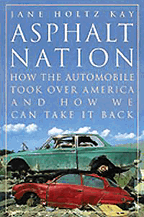
Asphalt Nation
How the Automobile Took Over America and How We Can Take it Back
by Jane Holtz Kay
New York: Random House, 1997.US $32.95
Review by James Miraglia
Imagine if 120 or so people died in a horrendous plane crash today. Then imagine 120 people lost their lives every single day of the year in a plane crash. Do you think there might be a little public outcry? Or a tremendous outcry — boycotts, congressional investigations, wall-to-wall television coverage?
As she demonstrates in this clear and readable book, America’s love affair with the auto has everything to do with price supports for highways and freeways, military protection of the world’s oil supplies (who paid for the $90 billion Persian Gulf Oil War? Not the people at the pump!), free parking, tax incentives for far-flung development, an economy dependent on news of new housing starts, the post-war Federal Housing Act which made mortgages affordable for the first time, but only for new suburban housing — and the damning list goes on and on. People are reacting to a market that is as far from the “ideal” neo-classical free-market as any centrally-controlled economy.ple are not ‘voting with their gas pedals,’ not victims of a born-to-lose ‘love affair,’ not opting for exurban flight out of pure passion or even a clear preference. They are responding to a rigged market.”Kay divides Asphalt Nation into three parts: “Car Glut: A Nation in Gridlock,” on the costs of car culture; “Car Tracks: The Machine That Made the Land,” dealing with history of car culture; and “Car Free: From Dead End to Exit” which offers solutions.One important chapter in the first section, “The Geography of Inequity,” exhaustively catalogs the social costs of car culture. By “car culture,” she means not simply a transportation system monopolized by automobiles, but the land use patterns it forces on us, and the actual limits on freedom and mobility we unconsciously accept for lack of any alternatives. For example, she explains how auto-dependent suburban enclaves discriminate and segregate by race, disability, and age. She shows how the prohibitive cost of car ownership maroons people on an economic and social island. The urban and rural poor in particular can’t get to jobs and services. Those too young or too old to drive a car can’t get to the store for a loaf of bread, and can’t get to the “local” school on their own for sports programs or to vote. Many persons with disabilities who cannot drive are unable to live independent lives.
Another important chapter, “The Road to Environmental Ruin,” details car culture’s many destructive effects on the natural and built environments. The indicators of an unsustainable car culture are many: asthma from tail-pipe emissions, loss of diversity due to habitat fragmentation, global warming, industrial pollution, pollution from oil exploration and refining, and the salination of freshwater ecosystems by road salts, and outright loss of natural habitats due to sprawled development.
Yet at times in this chapter, and elsewhere in this otherwise thoughtful book, Kay verges on a scattershot critique that bloodies almost everyone in sight, but misses some of the most deserving targets. For example, referring to the endangered Florida Panther, she says, “The Florida Panther dwindles… as a result of Interstate 75… while ‘sportsmen’ in off-road vehicles…launch their brutal odyssey and wreck more habitat.” Brutal odyssey? Hunting has been part of human culture since the beginning of our species. Besides, hunters tend to go on foot; the drivers of off-road vehicles who careen through the wilderness are not hunters but joy-riders filling out yet another new market created by automobile companies. Interstate 75, not sportsmen, fragmented the Panther’s main habitat, causing “genetic sink.” If there is an additional factor that has all but killed off the beautiful cat, it’s the pesticide run-off from sugar plantations — not additional roadside parking for hunters, but America’s Twinkie addiction.
The last section of the book, comprising Kay’s proposed solutions, is the smallest section, and the weakest. This may reflect the complexity and difficulty of changing an economy and society so completely awash in petroleum. Kay’s main solution is right on the money: make petroleum users pay the full cost of their habit, including negative externalities like pollution and health care. She calls for equalizing the level of taxpayer support for mass-transit, noting that we call spending on highways and airports “investment,” but “subsidize” mass transit. The point here is not to outlaw or abolish the automobile, but to bring some sense and fairness to transportation spending and to create a “market” that offers real alternatives.
If I am partly dissatisfied by Kay’s solutions, it is because she fails to fully recognize how car-dependency and petroleum addiction are, in a sense, only symptoms — albeit major ones — of the larger problem: an essentially unsustainable and unfair economic system. For example, she does not address the issue of oil supply. Some estimates show a supply crisis in only thirty years if current consumption rates continue. What will happen then? Electric cars? Greater investments in mass transit? Desertion of far-flung suburbs? If there is to be any hope of reversing the massive damage and inequity of auto-dependency, it will have to come by confronting the larger reality, of which transportation and land-use are key, but only partial, ingredients.
Asphalt Nation is worth the price of the hardcover just for the amount of current data it provides. Kay’s argument is cohesive and strong except for occasional politically-correct digressions that really do not belong in such a well thought-out book. It makes a great resource for progressive planners, environmentalists, and activists, and is an important start in the search for an alternative and sustainable future.
James Miraglia coordinates the Discovery Program at the Brooklyn Botanic Garden. He is also a student at Pratt Institute’s Graduate Center for Planning and the Environment.